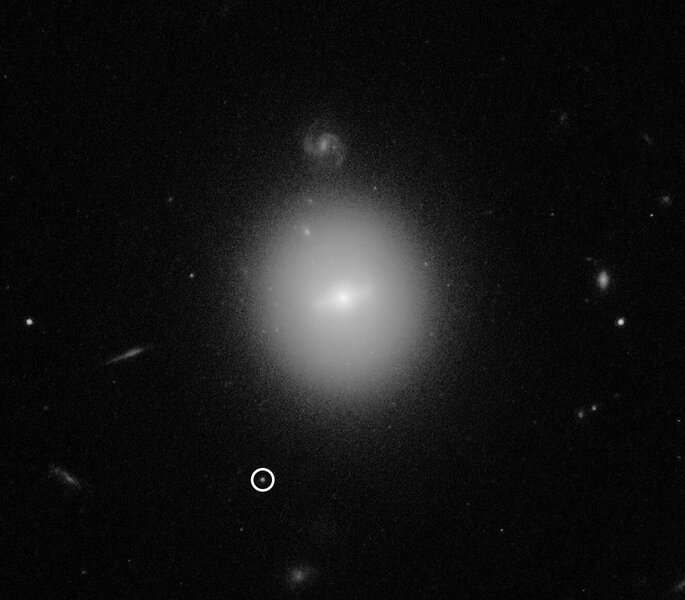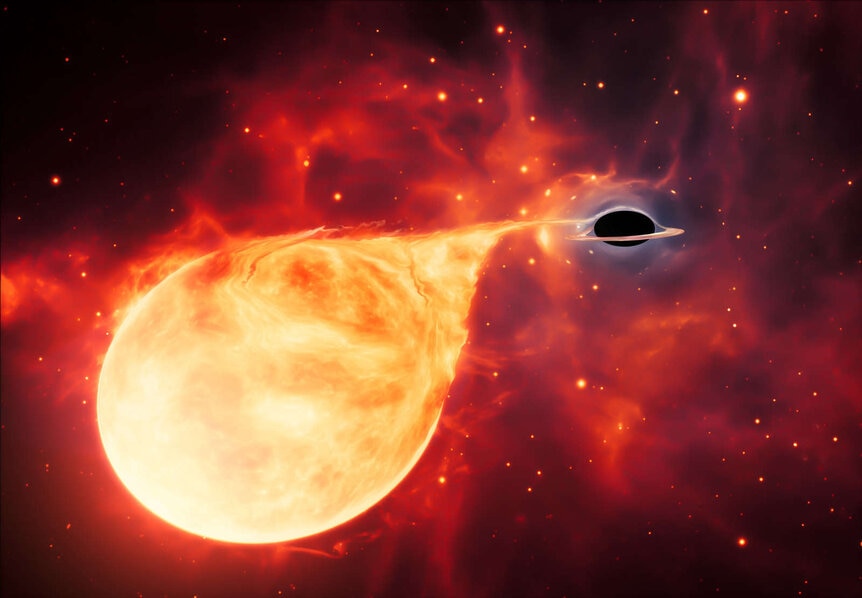Create a free profile to get unlimited access to exclusive videos, sweepstakes, and more!
How is an intermediate mass black hole like the Cookie Monster? They’re both really sloppy eaters

If you had to wager on a star vs. a black hole, you’d bet on the black hole to win every time.
But how it wins tells us a lot about it. Your standard-issue stellar mass black hole (one with, say, 5 to 100 times the mass of the mass of the Sun) would tidily (and tidally) pull material off the star and eat it slowly over time. A supermassive black hole (with over 100,000 times the mass of the Sun) could eat a star whole in one gulp, especially the ones at the top of the weight scale with billions of solar masses.
But intermediate-mass black holes are different. They’re sloppy eaters, and rip the star to shreds before gobbling up the vaporized meal. This releases a soul-crushing amount of energy, easily — easily — a billion times the Sun’s luminosity. These are ridiculously violent catastrophes, so of course astronomers gave them the lame name of tidal disruption events, or TDEs.
In 2006, astronomers saw just such an event: A huge flare of high-energy X-rays coming from a spot just outside a galaxy about 750 million light years from Earth. A Hubble image pinpointed the flare position to a small spot of light outside the galaxy, likely either a globular cluster or the remnants of a dwarf galaxy that had been eaten by the bigger galaxy.
I wrote an article with all the background info you need back in April 2020 (and also, even earlier, wrote an article on this event in 2018). The event, called 3XMM J215022.4−055108 (let’s just call it J2150), was observed by the Chandra X-ray Observatory and the XMM-Newton X-ray observatory, and using models of how stars are ripped apart and eaten, the black hole’s mass was found to be somewhere around 50,000–100,000 times the Sun’s.
That was a big deal. That would make it an intermediate-mass black hole, and, while many interesting and compelling observations indicate these kinds of black holes exist, none has ever been solidly confirmed.
A team of astronomers has reassessed this event, using updated models, and find that the black hole is likely even smaller, around 17,500 solar masses, a lot less than previously thought, and putting it solidly in the range of intermediate mass ones. They also find it spins rapidly but not as rapidly as you might expect, so strange things are afoot.
An intermediate-mass black hole — let’s call them IMBHs to save my poor, tired fingers — tear a star apart via tides. Gravity weakens with distance, so as a star gets closer to an IMBH the side of the star closer to it feels a much strong gravitational attraction than the far side of the star. This effect is what we mean by tides, and it gets stronger the closer the star gets. If it gets too close, riiiiiip. The star is torn apart.
The ex-star is now an extremely hot and long loop of gas around the IMBH. It gets pulled into a flat disk called an accretion disk, which gets infernally hot and slowly feeds into the black hole. The light coming from this flat disk can be used to measure the mass of the disk, but until now that only worked well for stellar-mass black holes and supermassive ones.
That’s how they found the mass to be a mere 17,500 solar masses. Even with inherent uncertainty in their measurements and models this still nails it as a bona fide IMBH.
But they can do more. Black holes spin. It’s a weird concept, because they don’t have a surface, really. But as matter falls in it spirals around like water going down a drain. This adds angular momentum to the black hole, which is similar to spin. Also — and this part is truly mind-freaking — as the black hole spins it drags the fabric of spacetime around it. If you were near a black hole and trying to fall straight in you’d still wind up revolving around it because space itself is whizzing around it (like if a rubber ducky will start to circle the drain because it’s carried by the bathtub water).
Scientists quantify this spin using a range from 0 (no spin) to 1 (spinning as fast as it can, essentially at the speed of light). A black hole that grows by, say, eating gas that falls in from a big galaxy will tend to have extreme spin, near 1, because that gas tends to spin around the black hole in the same direction (again like water down a drain), adding to its angular momentum. One that grows by eating random stars that can come in from any direction tends to have a lower spin, around 0.1 to 0.3.
Using the same models as they did to get the mass and carefully examining the X-rays from the event, the astronomers find the IMBH has a spin of 0.8. That’s weird. Not too fast, but not really slow either. Maybe it was spinning rapidly early on, but then started dining on stars like this last one, and that material fell in the wrong way and slowed the spin a little (like trying to force water down a drain against the main spin will slow the motion of that spin).
Either way (again if they’ve done this correctly) this is the first time an IMBH’s spin has been measured. That’s cool.
Irritatingly it’s hard to call this proof of the existence of IMBHs, but it’s pretty convincing, and this is certainly looking more and more like the way to bet.
These are rare events — only a handful have been detected — and only detected at all because we have big telescopes scanning the skies looking for short, bright events like it. We’re getting better all the time at finding and figuring out stuff like this. There’s a lot of incredible stuff going on in the Universe around us, and I’m glad we’re keeping our eyes open to see them.




























